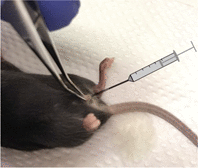Analysis of the Virulence of Uropathogenic Escherichia coli Strain CFT073 in the Murine Urinary Tract
- PMID: 34458450
- PMCID: PMC8376624
- DOI: 10.21769/BioProtoc.2129
Analysis of the Virulence of Uropathogenic Escherichia coli Strain CFT073 in the Murine Urinary Tract
Abstract
This urinary tract infection model was used to monitor the efficacy of a new virulence factor of the uropathogenic Escherichia coli strain CFT073 in vivo. The new virulence factor which we designated TIR-containing protein C (TcpC) blocks Toll-like receptor signaling and the NLRP3 inflammasome signaling cascade by interacting with key components of both pattern recognition receptor systems ( Cirl et al., 2008 ; Waldhuber et al., 2016 ). We infected wild type and knock-out mice with wildtype CFT073 and a mutant CFT073 strain lacking tcpC. This protocol describes how the mice were infected, how CFT073 was prepared and how the infection was monitored. The protocol was derived from our previously published work and allowed us to demonstrate that TcpC is a powerful virulence factor by increasing the bacterial burden of CFT073 in the urine and kidneys. Moreover, TcpC was responsible for the development of kidney abscesses since infection of mice with wildtype but not tcpC-deficient CFT073 mutants caused this complication.
Keywords: Uropathogenic Escherichia coli; Inflammasome; TIR-containing protein C; Toll-like receptor; Urinary tract infection.
Copyright © 2017 The Authors; exclusive licensee Bio-protocol LLC.
Figures



Similar articles
-
Uropathogenic Escherichia coli strain CFT073 disrupts NLRP3 inflammasome activation.J Clin Invest. 2016 Jul 1;126(7):2425-36. doi: 10.1172/JCI81916. Epub 2016 May 23. J Clin Invest. 2016. PMID: 27214553 Free PMC article.
-
Regulation of Expression of the TIR-Containing Protein C Gene of the Uropathogenic Escherichia coli Strain CFT073.Pathogens. 2021 May 1;10(5):549. doi: 10.3390/pathogens10050549. Pathogens. 2021. PMID: 34062817 Free PMC article.
-
The Promoter of the Immune-Modulating Gene TIR-Containing Protein C of the Uropathogenic Escherichia coli Strain CFT073 Reacts to the Pathogen's Environment.Int J Mol Sci. 2022 Jan 20;23(3):1148. doi: 10.3390/ijms23031148. Int J Mol Sci. 2022. PMID: 35163072 Free PMC article.
-
Inhibition of TIR domain signaling by TcpC: MyD88-dependent and independent effects on Escherichia coli virulence.PLoS Pathog. 2010 Sep 23;6(9):e1001120. doi: 10.1371/journal.ppat.1001120. PLoS Pathog. 2010. PMID: 20886104 Free PMC article.
-
[Progress in TcpC research].Zhejiang Da Xue Xue Bao Yi Xue Ban. 2013 Sep;42(5):481-5. Zhejiang Da Xue Xue Bao Yi Xue Ban. 2013. PMID: 24167126 Review. Chinese.
References
-
- Cirl C., Wieser A., Yadav M., Duerr S., Schubert S., Fischer H., Stappert D., Wantia N., Rodriguez N., Wagner H., Svanborg C. and Miethke T.(2008). Subversion of Toll-like receptor signaling by a unique family of bacterial Toll/interleukin-1 receptor domain-containing proteins. Nat Med 14(4): 399-406. - PubMed
-
- Dielubanza E. J. and Schaeffer A. J.(2011). Urinary tract infections in women. Med Clin North Am 95(1): 27-41. - PubMed
-
- Eurosurveillance editorial, t.(2015). ECDC publishes 2014 surveillance data on antimicrobial resistance and antimicrobial consumption in Europe. Euro surveillance 20(46). - PubMed
LinkOut - more resources
Full Text Sources

